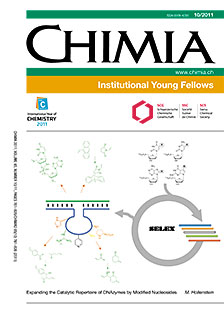New Carbon- and Sulfur-based Ligands in Catalysis
DOI:
https://doi.org/10.2533/chimia.2011.806Keywords:
Asymmetric synthesis, N-heterocyclic carbenes, Homogeneous catalysis, SulfoxidesAbstract
Homogeneous catalysis is a field of research that has gained central importance in both organic and inorganic chemistry and the use of well-defined ligand systems in the synthesis of transition metal complexes has had an enormous impact on the development of such catalysts. Neutral, two-electron donor ligands based on phosphorous and nitrogen have been tremendously successful as ancillary entities for late-transition metal (LTM) catalysts, whereas ligands based on anionic nitrogen, oxygen and the cyclopentadienyl motif (Cp?) have propelled early-transition metal (ETM) catalysis forward. We believe that expanding the ligand families capable of acting as successful entities in metal-mediated reactivity and catalysis is crucial for future discoveries in this field. Research in our group therefore tries to identify new non-chiral and chiral ligands for late-transition metal chemistry that are based on neutral, two-electron carbon and sulfur donor atoms. In particular, we have until now focused on the development of modular, monodentate N-heterocyclic carbene ligands (NHCs) that can serve as a basis for the development of chiral ligand frameworks for the application to asymmetric catalytic transformations. In the second major research project developed over the last six years, we have started an investigation on the use of chelating sulfoxide-based ligands in asymmetric late transition-metal based catalysis.Downloads
Published
2011-10-26
Issue
Section
Scientific Articles
License
Copyright (c) 2011 Swiss Chemical Society

This work is licensed under a Creative Commons Attribution-NonCommercial 4.0 International License.
How to Cite
[1]
R. Dorta, Chimia 2011, 65, 806, DOI: 10.2533/chimia.2011.806.







